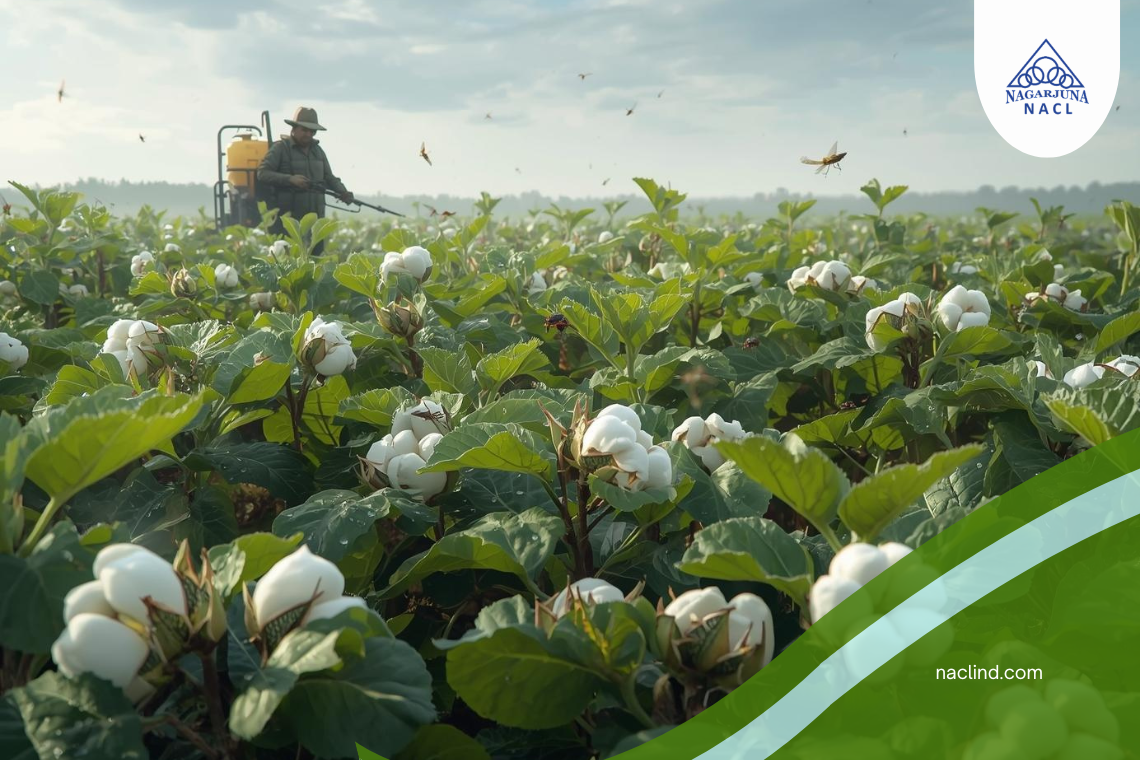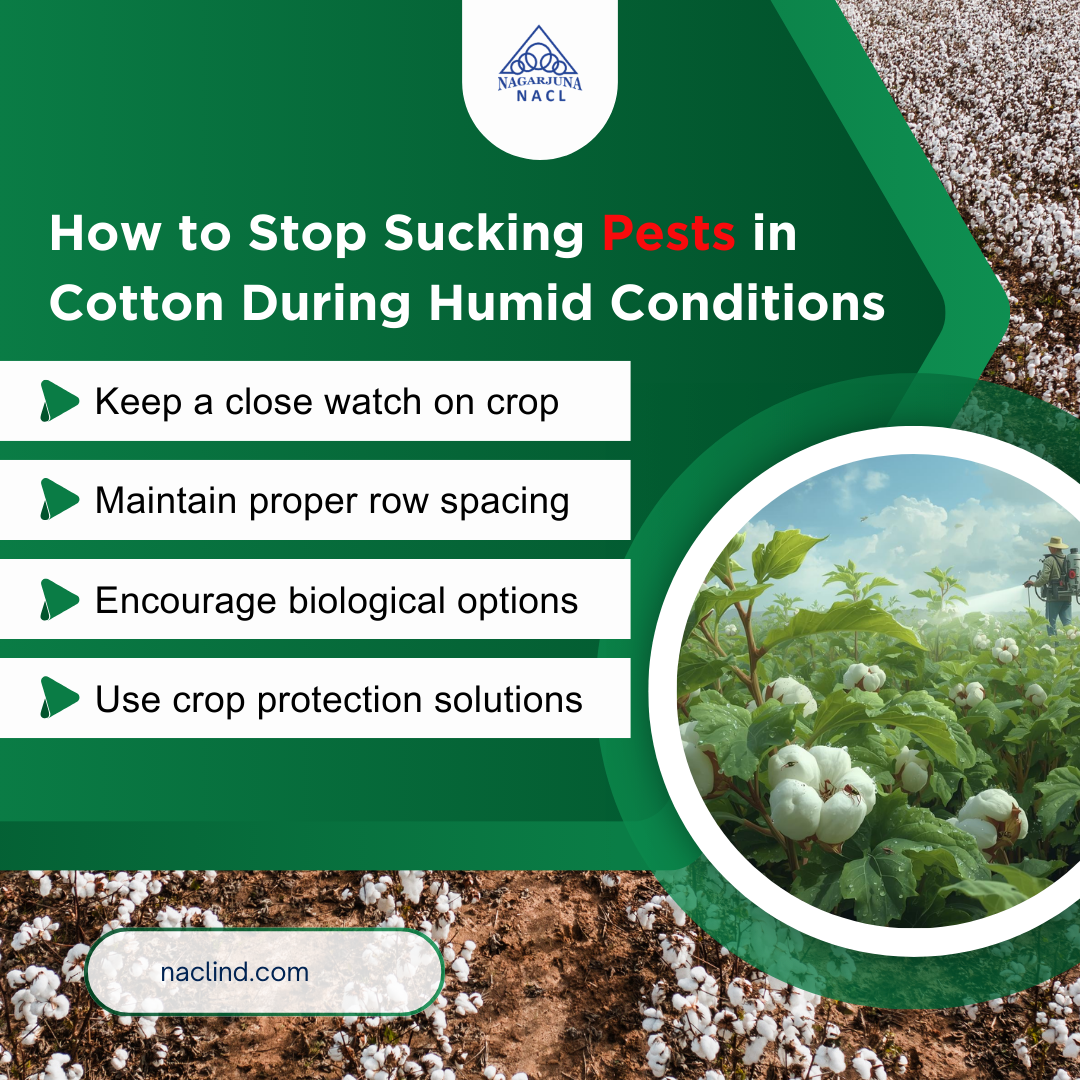
How to Stop Sucking Pests in Cotton During Humid Conditions
Cotton is rightly called “White Gold” in India. It supports the livelihood of millions of farmers and powers our textile industry. States like Telangana, Maharashtra, Gujarat, Andhra Pradesh, and Karnataka grow cotton on a large scale. But one common enemy that farmers often worry about during the rainy season is sucking pests.
These tiny but dangerous pests—aphids, jassids, thrips, and whiteflies—weaken cotton plants by sucking out their sap. The damage shows up as curled or yellow leaves, slow growth, and poor boll formation. Worse, pests like whiteflies also spread viral diseases such as leaf curl virus, which can destroy entire fields if left unchecked.
The problem becomes more serious during the humid and cloudy months of the monsoon. High moisture and warmth provide the perfect conditions for these pests to multiply quickly. That’s why the timely protection is necessary if farmers want to save their cotton crop.
The good news is that farmers don’t have to fight this battle alone. With the right mix of field practices and safe use of crop protection solutions, cotton can be protected even under tough weather conditions.
Key Takeaways
- Sucking pests spread fast in humid and cloudy weather.
- The first 40–50 days after sowing are critical for pest control.
- Integrated pest management (IPM) gives the best results.
- Correct timing and dosage of cotton insecticides ensures effective protection against pests.
Why Sucking Pest Control Matters in Cotton?
- Weak Plants: Constant sap loss makes cotton leaves curl and turn pale.
- Reduced Growth: Damaged leaves cannot make enough food, so plants remain stunted and weak.
- Disease Spread: Whiteflies in cotton spread the leaf curl virus, one of the most devastating cotton diseases in India.
- High Risk in Monsoon: Humid weather is ideal for pest multiplication, making it harder to control once they spread.
- Yield Loss: Heavy infestations can cut yield by 30–50% if not managed on time.
Best Practices for Controlling Sucking Pests in Cotton
1. Keep a Close Watch on the Crop
Farmers should regularly check fields for early signs:
- Aphids: Tiny green or black clusters on leaves.
- Jassids: Small insects causing leaf edges to curl and turn yellow.
- Thrips: Very small insects that make silvery patches on leaves.
- Whiteflies: Small, white-winged insects that fly out when plants are shaken.
2. Farm Practices That Help
- Timely Sowing: Avoid sowing late to reduce peak pest attack.
- Right Spacing: Proper row spacing improves airflow and reduces humidity around plants.
- Weed Management: Remove weeds, as they act as alternate hosts for pests.
- Balanced Fertilizer Use: Too much nitrogen attracts pests—apply in balanced doses.
3. Natural & Biological Options
- Encourage friendly insects like ladybird beetles and lacewings that feed on sucking pests.
- Use Neem-based sprays (Azadirachtin) early in the crop stage to keep pest pressure low.

4. Crop Protection Solutions for Tough Infestations
If pest numbers go beyond the economic threshold level (ETL), insecticides become necessary.
Common Options:
- Imidacloprid / Thiamethoxam – effective on aphids and jassids.
- Fipronil / Acetamiprid – good against thrips and whiteflies.
- Spiromesifen – controls whitefly nymphs and mites.
Do’s:
- Spray in the morning or evening for better results.
- Use the recommended dose only—never more.
- Cover the crop uniformly with a proper sprayer nozzle.
- Rotate between different chemical groups to avoid resistance.
Don’ts:
- Don’t spray before heavy rain as this would result in washing away the solution.
- Don’t use the same product repeatedly.
- Don’t spray without gloves, masks, and protective clothing.
5. Integrated Pest Management (IPM) Approach
For lasting results, farmers should mix different methods:
- Put up yellow sticky traps to monitor the whiteflies.
- Start with neem or bio-products; shift to selective insecticides only if pest levels rise.
- Use intercropping or crop rotation to break the pest cycles.
- Spray only after checking ETL (e.g., 6–8 jassids/leaf, 8–10 whiteflies/leaf).
Special Care During Humid Season
- Field Cleanliness: Remove the weeds and alternate host plants near cotton fields.
- Water Management: Avoid waterlogging—excess moisture increases pest pressure.
- Safe Spraying: Spray when the wind is low for better coverage.
- Farmer Safety: Always wear protective gear while spraying.
Conclusion: Safeguarding White Gold
Cotton farming is a lifeline for millions of Indian farmers. But during the monsoon, sucking pests are a constant threat. Farmers who regularly monitor their fields and act early with a mix of cultural practices, bio-products, and selective insecticides can keep pests under control and protect yields.
Companies like NACL Industries are providing farmers with reliable, India-specific crop protection solutions that help them face these challenges with confidence.
The message is simple: Don’t wait for damage to show up—act early, act smart, and protect your cotton from sucking pests.
FAQs
1. Which pests attack the cotton crop during humid weather?
Aphids, jassids, thrips, and whiteflies are the main sucking pests that damage the cotton crops.
2. Why do pests spread more during the monsoon?
High humidity and cloudy weather create favourable conditions for rapid pest multiplication.
3. Are neem-based sprays enough for control?
Neem sprays work well in early stages but may not be enough when pest levels are high. In such cases, selective insecticides are needed.
4. How can farmers prevent pest resistance?
Rotate different groups of insecticides, avoid over-spraying, and combine sprays with farm practices for long-term success.

